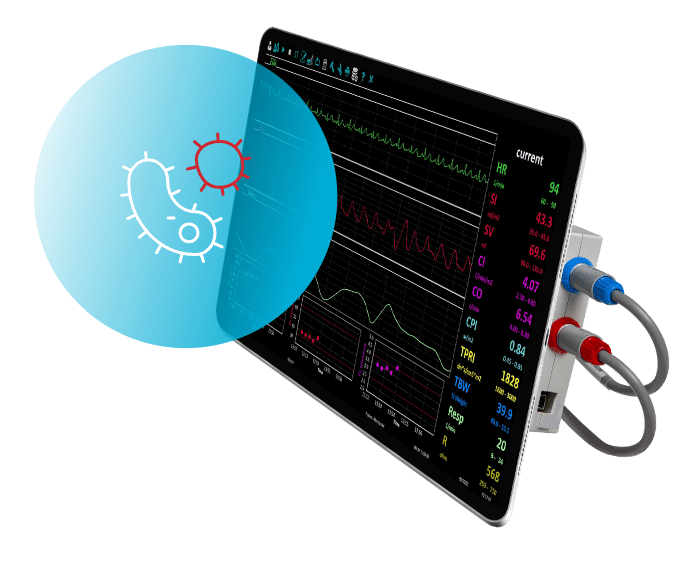Infectious Disease – COVID 19
NICaS solution closes treatment gaps by providing accurate and continuous cardiorespiratory and fluid data. This enables: efficient patient management, online drug and oxygen titration, optimized treatment, clear understanding of oxygen delivery and recognizing early signs of oxygen delivery failure.
Challenges
Current protocols advise against mechanical ventilation. This makes managing severe patients extremely challenging due to missing tissue oxygenation parameters.
Limited knowledge about the virus requires closer patient surveillance.
Risk of medical team contamination.
Solutions
Closes the information gap to enable better treatment strategy.
Provides information remotely without risk to medical teams.
Covid-19 In Numbers:
0.4% mortality rate
Over 6.3 Million deaths worldwide
7-day median hospital stay in ICU resulting in various comorbidities

Related Clinical Markets
Related Clinical Studies
Utility of NICaS Non-Invasive Hemodynamic Monitoring in Critically Ill Patients with COVID-19
Authors: Wisam Zabeeda, Jonah Benjamin Cohen, Anat Reiner Benaim, Shiri Zarour, Yael Lichter, Idit Matot, Or Goren Conclusion: Non-invasive hemodynamic monitoring via the NICaS device
The Impact of Positive Inotropic Therapy on Hemodynamics and Organ Function in Acute Heart Failure: A Differentiated View
Authors: Juan Cheko, Nikolaos Patsalis, Julian Kreutz, Dimitar Divchev, Georgios Chatzis, Bernhard Schieffer, Birgit Markus Conclusion: Patients with acute decompensated HF benefit from positive inotropic
Comparing elective and emergency caesarean section by using bioimpedance method
Authors: Zuhal Çavuş, Ayşe Vahapoğlu, Ülkü Aygen Türkmen, Fatma Ketenci Gencer, Elif Yıldız Conclusion: Understanding normal hemodynamic values before, during, and after C/S is feasible
Noninvasive Hemodynamic Evaluation Following TAVI for Severe Aortic Stenosis
Authors: Tzlil Grinberg, Yaron Aviv, Mordehay Vaturi, Leor Perl, Maya Wiessman, Hanna Vaknin-Assa, Pablo Codner, Yaron Shapira, Ran Kornowski, Katia Orvin Conclusion: Unique short‐term adaptive
Correlation of Impedance Cardiography-Derived and Cardiac Magnetic Resonance-Derived Stroke Volumes
Authors: Pedram Hassan-Tash, Umar Ismail, Iain D C Kirkpatrick, Amir Ravandi, Davinder S Jassal, Brett Hiebert, Malek Kass, Richard A Krasuski, Ashish H Shah Conclusion:
Non-invasive hemodynamic profiling of patients undergoing hemodialysis-a multicenter observational cohort study
Authors: Keren Doenyas-Barak, Marcia H. F. G. de Abreu, Lucas E. Borges, David Pereg, Ilya Litovchik, Shmuel Fuchs and Sa’ar Minha Conclusion: Non-invasive assessment of
The value of non-invasive measurement of cardiac output and total peripheral resistance to categorize significant changes of intradialytic blood pressure: a prospective study
Authors: Yunlin Feng, Yurong Zou, Yifei Zheng, Nathan W Levin, Li Wang Conclusion: This technology provides multi-dimensional insight into intradialytic hemodynamic parameters, which may be
Bioimpedance based clinical decision making in hemodialysis patients decreases episodes of hypotension
Authors: Katzir, Zeev; Petrohno, Oksana; Leiba, Adi; Sharipov, Tatiana; Rubin, Olga; Gaber, Yahya; Hausman, Michel Conclusion: These preliminary results suggest that clinical decision-making based on
Directed antihypertensive therapy improves growth restriction and perinatal mortality in women with chronic hypertension.
Authors: David Chaffin, Jesse Cottrell, Kelly Cummings, David Jude. Maternal Hypertension Center at Cabell Huntington Hospital, Virginia, USA Conclusion: Impedance cardiography-directed antihypertensive therapy during early
